Click below to jump to an article of interest.
CYGNSS Satellite Mission Extended
NASA has extended the Cyclone Global Navigation Satellite System (CYGNSS) mission through at least 2023 and possibly through 2026. The constellation of microsatellites designed, built and operated by SwRI with the University of Michigan has made history over the past four-plus years, penetrating thick clouds and heavy rains to accurately assess wind speeds and better understand hurricane intensification.
The NASA senior review panel rated the mission extension proposal as excellent, based on the current health of the constellation of instruments, particularly considering the low-cost nature of the sensors. They also found that the operations team has been agile in dealing with unexpected GPS signal variability, using state-of-the-art engineering automation to handle instrument anomalies.
The microsatellites — each roughly the size of a carry-on suitcase — make frequent measurements of ocean surface winds to monitor the location, intensity, size and development of tropical cyclones. Flying in formation, the spacecraft cover an orbital swath that passes over most of the Earth’s hurricane-producing zone, up to 35 degrees north and south of the Equator.
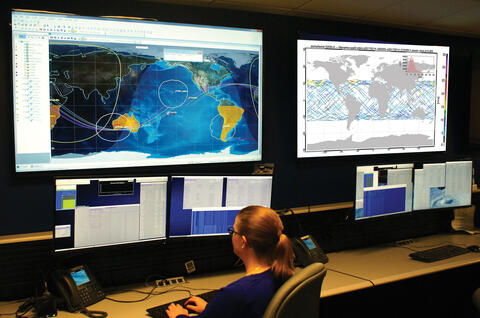
Courtesy of NOAA/NASA/University of Michigan
In addition to building the eight microsatellites in the CYGNSS constellation, SwRI runs the mission operations center from our Boulder, Colorado, location. The constellation uses GPS signals that penetrate thick clouds and heavy rains to accurately assess wind speeds and better understand hurricane intensification.
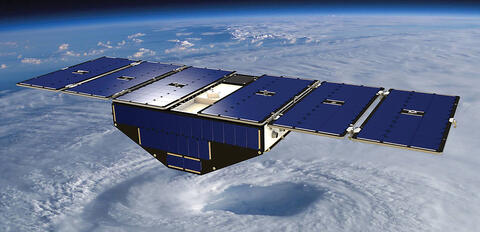
“Launched in late 2016, the spacecraft have provided round-the-clock surface wind speed measurements to help improve intensity forecasting of tropical cyclones,” said SwRI’s William Wells, CYGNSS operations phase systems engineer. “We continue to develop new versions of algorithms that improve the data, in addition to exploring novel applications, such as soil moisture monitoring and ionospheric modeling.”
This science is critical because, over the past few decades, forecasters have improved hurricane path predictions significantly, but the ability to predict the intensity of storms has lagged. Flying aircraft through storms to collect data is difficult and dangerous, and prior space-based technology was incapable of seeing through the heavy precipitation common in hurricanes. GPS signals, however, penetrate intense rain, and the CYGNSS microsatellites use these signals, reflected off the ocean surface, to calculate wind speeds.
“Moving forward, we continue adapting the mission for new investigations related to tropical cyclones, oceanography and land science applications, among many others,” said SwRI’s Jillian Redfern, CYGNSS project manager and mission operations manager. “For instance, CYGNSS has detected and mapped flood inundation under dense forest canopies and monitored flooding in and around Houston and Havana after landfalls by Hurricanes Maria and Irma, respectively.”
“The CYGNSS project team is delighted to receive approval for a three-year mission extension and is very appreciative of NASA for its continuing support,” said Dr. Chris Ruf, the CYGNSS principal investigator from the University of Michigan. “The science investigations to date using ocean surface wind measurements to study tropical meteorology in general, and tropical cyclone processes and forecasting in particular, can continue to progress and improve our understanding of the physical processes involved and our ability to predict them. I’m sure I speak for all the members of the science and operations teams when I say we are very excited about what the next three years will bring.”
Evaluating AI-Assisted Design in Air Taxis
SwRI has received a four-year Defense Advanced Research Project Agency (DARPA) contract to develop air taxi technology while evaluating the capabilities of artificial intelligence-augmented design systems. The project is part of DARPA’s Symbiotic Design for Cyber Physical Systems program.
Air taxis are short-range electric aircraft designed to carry a small number of passengers relatively short distances. Many companies are currently developing different air taxi designs.
“Air taxis are an exciting idea that also present unique engineering challenges,” said Sydney Whittington, the project principal investigator. “In many ways, it’s the perfect concept to test an AI’s design capabilities.”
Designing an air taxi presents several engineering challenges and a wide range of design options. Larger versions include quadrotor layouts, which use four spinning rotors to lift the aircraft. Others use many distributed propellers for vertical take-off and landing while relying on traditional lifting surfaces (wings) for the majority of the flight profile.

Engineers led by Dr. James Walker, director of SwRI’s Engineering Dynamics Department, will create air taxi components that an AI computer design system will use to design the completed vehicle.
“What’s exciting about the air taxi is that advances in controls, batteries and electric motors have completely opened up the design space,” Walker said. “There are lots of potentially viable designs to be explored.”
SwRI will analyze the AI’s air taxi designs and evaluate its design capabilities, judging AI-augmented designs based on whether they meet specific criteria. These standards include that a system be no larger than two cars parked beside each other, with a useful range of at least 20 to 30 miles and capable of carrying at least two people. The specific requirements will be developed as part of the program.
“There’s less room for human error with AI-driven design,” Whittington said. “Plus, AI systems are capable of thinking far outside the box and come up with concepts that people never would have.”
For instance, in 2004, NASA announced that its Evolutionary software, an AI program, had designed a powerful, compact antenna for use on a collection of small satellites set to be launched into orbit around the Earth. The AI software had observed millions of potential designs before delivering an unusually shaped antenna that met all of the requirements.
Whittington’s team will also collaborate with Vanderbilt University researchers on modeling the air taxi’s cyber-physical systems (CPS), computer systems that link sensing, control and computation between user and machine. They are increasingly common in automobiles and can be found on nearly every commercial and military aircraft.
SwRI Enhances Automotive Catalyst Testing
Engineers integrated a mass spectrometer with existing SwRI technology to expand capabilities to evaluate engine emissions control technologies. These aftertreatment systems, which treat exhaust and reduce harmful pollutants escaping into the environment, require stringent testing. Incorporating a mass spectrometer enables a broader range of aftertreatment performance evaluations in real time.
Mass spectrometers identify molecules by analyzing their mass-to-charge ratio, detecting chemicals invisible to other instruments. SwRI’s Universal Synthetic Gas Reactor (USGR®) tests catalysts with a Fourier Transform Infrared (FTIR) spectrometer, which uses IR radiation to identify and quantify molecules present in a gas sample. Different chemical structures absorb light at specific wavelengths, producing unique spectral fingerprints.
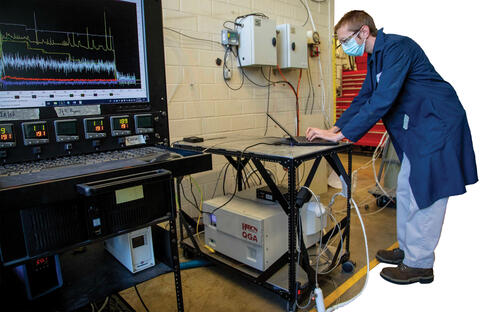
The FTIR monitors pollutants, while the mass spectrometer detects hydrogen, oxygen and dinitrogen formation, providing data to build comprehensive scientific models of the catalyst. The merger of the technologies enables testing of three-way catalysts in real time.
“Integrating a mass spectrometer with the USGR system overcomes limitations of the FTIR spectrometer, which cannot monitor chemicals that are infrared inactive,” said Dr. Grant Seuser, a post-doctoral researcher in SwRI’s Powertrain Engineering Division, who led the project. “The mass spectrometer can detect a broader range of exhaust components, allowing a more complete picture of aftertreatment system performance.”
The successful integration of a mass spectrometer with the USGR system widens the scope of testing possibilities beyond aftertreatment systems. Other uses include measuring engine emissions directly, battery testing, environmental and chemical processes monitoring, and much more. SwRI offers the specialized evaluation and development services to a range of clients, including engine, vehicle and catalyst manufacturers.
CODEX ADDS DATING APP
SwRI scientists have expanded the capabilities of the prototype spaceflight instrument Chemistry Organic and Dating Experiment (CODEX), designed for field-based dating of extraterrestrial materials. CODEX now uses two different dating approaches based on rubidium-strontium and lead-lead geochronology methods.
“The central aim of CODEX is to better understand some of the outstanding questions of solar system chronology, such as the duration of the late heavy bombardment or how long Mars was potentially habitable,” said SwRI’s F. Scott Anderson, who is leading the development of the instrument.
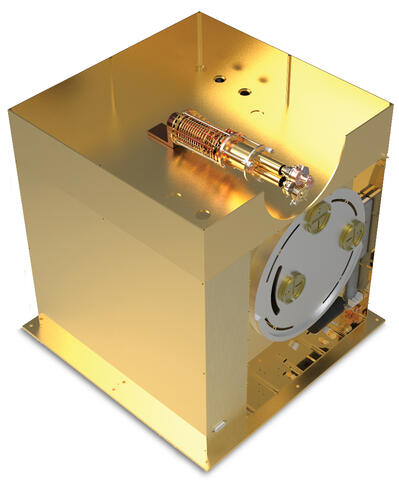
Scientists estimate the ages of inner solar system objects by counting impact craters, with the assumption that objects with more craters have existed for longer periods of time. These estimates are partially calibrated by the ages of moon rocks obtained by astronauts in the 1960s. However, in areas not explored by astronauts, age estimates could be wrong by hundreds of millions to billions of years. Thus, dating more samples is critical to our understanding of the age of the solar system.
Earlier versions of CODEX exploited the natural radioactive decay of rubidium into strontium to measure how much time had elapsed since a rock sample formed. In addition to that method, CODEX now measures lead isotopes produced by the natural decay of uranium in a sample to obtain an independent estimate of its age.
Scientists are interested in dating hundreds of potential sites on the Moon and Mars, but sample return missions are expensive and time-consuming. For this reason, CODEX is designed to be compact enough to be incorporated into a spacecraft to conduct onsite dating.
“This experiment raises the prospect of equipping a future lander mission to the Moon or Mars with a single dating instrument capable of exploiting two complementary isotopic systems,” Anderson said. “This combination would permit consistency checks and afford us a more nuanced understanding of planetary history.”
Evaluating Aquifer Impacts
SwRI developed an integrated hydrologic computer model to evaluate the impact different wastewater disposal facilities have on the Edwards Aquifer, the primary water source for San Antonio and surrounding communities. The research results will guide authorities on what actions to take to protect the quality and quantity of water entering the aquifer.

“We studied the Helotes Creek Watershed because it is entirely in the contributing and recharge zones of the Edwards Aquifer,” said SwRI’s Mauricio Flores, who helped lead the project. “Rainfall and bodies of water over these key zones replenish the aquifer.”
The team developed a base case model, replicating current septic systems already located in the watershed, and then evaluated the effects of adding wastewater disposal facilities to the area. Scenarios evaluated included additional septic or onsite sewage systems, facilities that reuse wastewater for irrigation and systems that dispose of wastewater in nearby creeks or rivers.
“We considered a range of hypothetical scenarios consistent with possible residential development in the Helotes Creek Watershed area,” said Dr. Ronald Green, SwRI technical advisor and project manager. “Our results predicted that installing additional wastewater systems in the region, regardless of type, would increase the amount of wastewater discharged to the environment and significantly degrade the watershed and the quality of water recharging the Edwards Aquifer.”
While the findings are applicable to most watersheds in the aquifer’s contributing and recharge zones, SwRI researchers recommend expanding the study beyond Bexar County.
“The results of the study not only highlight the impact development could have on the aquifer but can also be used to prioritize protection of land, rivers and streams that recharge the aquifer,” said Flores.
The two-year study was funded through the city of San Antonio’s Edwards Aquifer Protection Plan (EAPP) under the direction of the San Antonio River Authority.
NEW PROTECTIVE COMPUTATIONAL MODELS
SwRI is creating computer models to accurately assess how materials and structures behave under impacts, blasts and shocks. The U.S. Department of Defense project will involve sophisticated state-of-the-art material tests on protective structures commonly used on military bases and at embassies as well as other vulnerable structures in foreign countries.
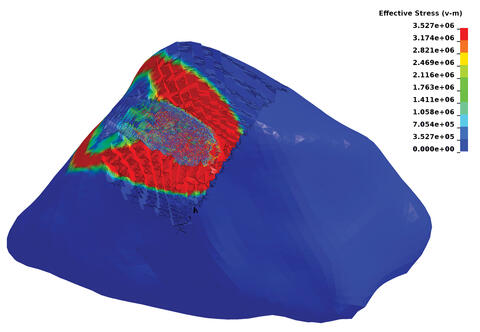
This computational model of a rock impacted at 2 kilometers per second shows how stress waves propagate from the point of impact, fragmenting the material. SwRI researchers are developing new computer models to predict how materials react to impacts, blasts and shocks.
“Computer models of this kind can be very challenging,” said computational mechanics Manager Dr. Sidney Chocron. “These materials are taken to extreme pressures, temperatures and rates — conditions that are quite difficult for a computer to simulate. To meet these challenges, we need to feed the computers precise information about the conditions that cause a material to crack or fail.”
Chocron is taking a “building-block” approach to create the most accurate computer models. He started by testing small specimens at different temperatures and pressures and will progress to small-scale shock and blast experiments. He will gradually build up to full-scale blast experiments, comparing computer models throughout the process to ensure accuracy.
For the ballistic tests, Chocron is utilizing SwRI’s specialized facilities, including its two-stage light gas gun system and the SwRI-developed split-Hopkinson pressure bar.
“The question we’re striving to answer is whether a building or bridge will withstand a terrorist attack or any kind of significant ballistic event,” Chocron said. “Computer models are often utilized for their predictive accuracy. Experiments can be expensive, but if you’re building a valuable structure that might be attacked, you want to be certain it won’t fail.”
The project will support weapons effects research programs at the U.S. Army Engineer Research and Development Center and other potential DOD agencies.
Learn more at Methane Leak Detection.
SwRI Studies Massive Metallic Asteroid
An SwRI scientist published new findings about the asteroid 16 Psyche, including the first ultraviolet observations, painting a clearer view of the asteroid than was previously possible.
At about 140 miles in diameter, Psyche is one of the most massive objects in the main asteroid belt orbiting between Mars and Jupiter. Previous observations indicate that Psyche is a dense, largely metallic object thought to be the leftover core of a planet that failed in formation.
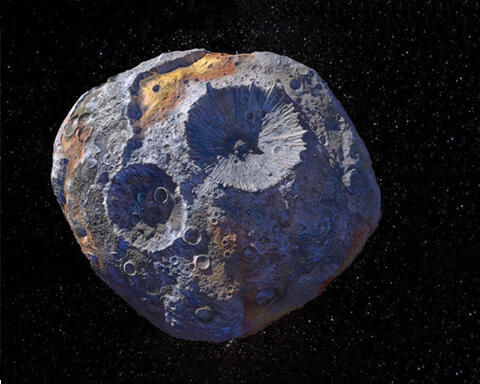
Courtesy of MAXAR/ASU/P. RUBIN/NASA/JPL-CALTECH
“We’ve seen meteorites that are mostly metal, but Psyche could be unique in that it might be an asteroid that is totally made of iron and nickel,” said Dr. Tracy Becker, lead author of the paper published in The Planetary Science Journal. “Earth has a metal core, a mantle and crust. It’s possible that as a Psyche protoplanet was forming, it was struck by other objects in our solar system and lost its mantle and crust.”
Becker’s study comes as NASA prepares to launch the Psyche spacecraft in 2022 to learn more about planetary cores. Metal asteroids are relatively rare in the solar system, and scientists believe Psyche could offer a unique opportunity to see inside a planet.
“We were able to identify for the first time on any asteroid what we think are iron oxide ultraviolet absorption bands,” Becker said. “This is an indication that oxidation is happening on the asteroid, which could be space weathering, a result of the solar wind hitting the surface.”
The asteroid’s surface could be mostly iron, but she noted that the presence of even a small amount of iron could dominate UV observations.
“What makes Psyche and the other asteroids so interesting is that they’re considered to be the building blocks of the solar system,” Becker said. To understand what really makes up a planet and to potentially see the inside of a planet is fascinating.”
Using AI to Train Military Medical Personnel
SwRI is developing a machine vision tool to help the U.S. Department of Defense assess the biomechanical movements of military medical personnel during training exercises.
The simulation-based training system will compare medical trainee performance to that of experts whose physical motions, or kinematics, have been prerecorded and analyzed in 3D with artificial intelligence.
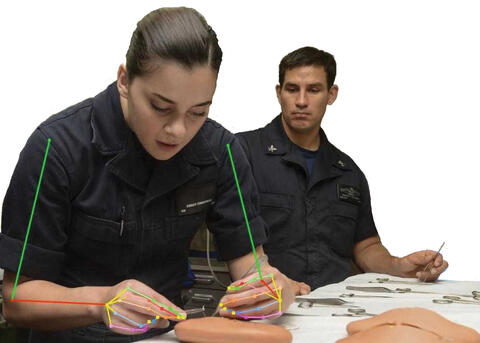
“Military medical training relies on subjective human evaluations where feedback may vary among trainers,” said Dr. Dan Nicolella, who leads the Institute’s Human Performance Initiative with Kase Saylor. “SwRI’s research will help both instructors and trainees objectively observe how well they are performing a specific task, providing both a quantitative score, based on expert task performance, and task-specific feedback to improve performance.”
The $1.25 million project, funded through the Medical Technology Enterprise Consortium (MTEC), is part of a larger DOD effort to improve patient safety and quality of care using more capable medical simulation technologies.
SwRI is adapting its markerless motion capture technology (BIOCAP) used to assess the biomechanics of athletes and for clinical applications. SwRI’s mocap technology leverages computer vision algorithms to circumvent the tedious process of attaching physical markers to a human subject to capture 3D motion data. Standard cameras capture video of human subjects, and custom machine learning algorithms quantify individual biomechanical performance for research, clinical and sports science applications
SwRI uses machine learning to train the automated assessment system using data collected as top professionals complete specific medical tasks. The project will assess the detailed performance of trainees when they suture wounds and provide other combat and hospital care requiring precise hand movements or physical orientations.
“We will develop advanced machine learning algorithms used in 3D markerless motion capture video analysis to improve military healthcare training,” Nicolella added.
Design sCO2 Oxy-Fuel Turbine
With funding from the U.S. Department of Energy and other organizations, an SwRI-led team is designing a 300 MWe supercritical carbon dioxide (sCO2 ), oxy-fuel turbine for use in a direct-fired sCO2 power plant. The turbine, which can use coal syngas or natural gas as a fuel source, minimizes harmful emissions released to the environment.
“This project leverages the sCO2 power cycle and incorporates a direct-fired combustor like a traditional gas turbine but at much higher pressures and in a pure CO2 environment,” said Institute Engineer Dr. Jeff Moore, the project leader. “A power plant built with this technology can burn both coal and natural gas at state-of-the-art efficiency with truly zero emissions. The technology offers near 100% carbon capture, while producing no oxides of nitrogen or sulfur emissions typical of traditional coal-fired power plants.”
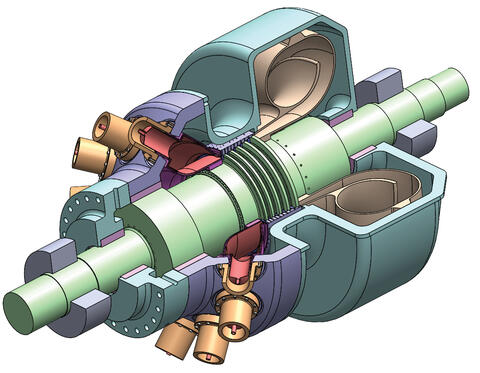
Coal syngas is created by partially combusting coal to create a gaseous stream of carbon monoxide and hydrogen. The process separates sulfur, mercury and other pollutants instead of releasing them into the atmosphere. That stream fuels the turbine and, when burned with pure oxygen, produces only water and near-pure CO2 , which can be captured and sequestered for other uses.
“Our goal is to design the turbine for the coal plant of the future,” said Stefan Cich, who is also leading the effort. “As more renewable energy is added to the energy mix, we need to develop smaller, efficient power plants that can come online quickly and meet energy demands when renewable sources are not available, while still reducing overall emissions.”
SwRI will be collaborating with General Electric Global Research Center, Air Liquide, 8 Rivers Capital LLC, Electric Power Research Institute Inc., Purdue University and the University of Central Florida on this “Coal FIRST” project.
Hacking EV Charging
As part of an automotive cybersecurity research initiative, SwRI engineers simulated a malicious attack to interfere with the charging process of an electric vehicle (EV).
The SwRI team reverse-engineered the signals and circuits on an EV and a J1772 charger, the most common interface for managing EV charging in North America. The researchers successfully disrupted vehicle charging with a spoofing device developed in a laboratory using low-cost hardware and software.
“This initiative was designed to identify potential threats in common charging hardware as we prepare for widespread adoption of electric vehicles in the coming decade,” said Austin Dodson, the research computer scientist who led the project. As automotive consumer and manufacturing trends move toward widespread vehicle electrification, market share of EVs is expected to grow to 30% by 2030, according to the International Energy Agency. The cybersecurity of charging technology and infrastructure will become increasingly important as demand for EVs grows.
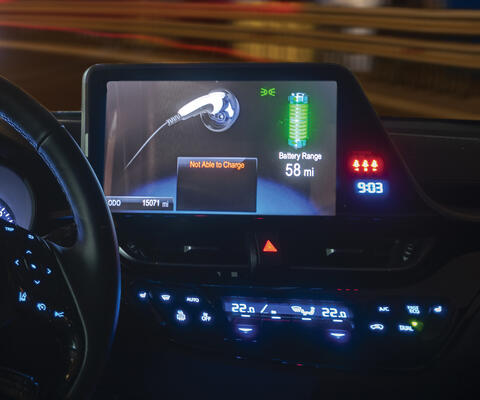
SwRI performed three manipulations: limiting the rate of charging, blocking battery charging and overcharging. An SwRI-developed “man-in-the-middle” (MITM) device spoofed signals between charger and vehicle. Researchers also drained the battery and generated signals to simulate J1772 charging rates.
When overcharging, the vehicle’s battery management system detected a power level that was too high and automatically disconnected from charging. To limit charging, the MITM device requested the smallest charge allowed (6 amps) to dramatically reduce the charging rate. To block battery charging, a proximity detection signal barred charging and displayed the warning: “Not Able to Charge.”
“Discovering vulnerabilities in the charging process demonstrates opportunities for testing standards for electric vehicles and charging infrastructure,” said Victor Murray, manager of SwRI’s cyber-physical systems section.
SwRI Adapts Ancient Protective Coatings
SwRI scientists have developed a new microencapsulation technique based on an ancient method used to seal the wood used in shipping vessels. It took nearly a decade to develop this natural non-hazardous, non-gelatin-based, formaldehyde-free, emulsion-based encapsulation system.
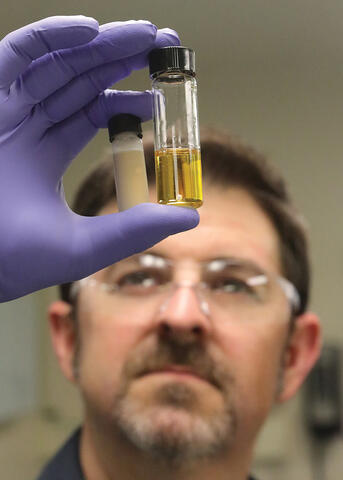
“Drying oils have been used for centuries to treat wood and in paints or coatings,” Staff Scientist Dr. Jamie Oxley said. “Part of the goal for encapsulation is to protect the core. If drying oils work well on a macroscale, on a ship, why not at microscales for microcapsules?”
The Institute has been involved in encapsulation research for more than 70 years, often using common emulsion-based gelatin, formaldehyde or hazardous precursors to create the outer shells and protect product ingredients. The drying oil encapsulation process focuses on the materials used to make the outer shell or matrix. Initial experiments were successful enough to pursue internal research funding to develop a technique that meets client desires for a new, less hazardous encapsulating material.
“Drying oils are a narrow class of natural oils that autoxidize when exposed to air,” Oxley said. “We repurposed this thousand-year-old drying oil chemistry to use as a natural material for the microencapsulation of a variety of active ingredients, including fragrances, phase change materials and pesticides.”
Mixed Metabolic Menu Possible at Saturn Moon
Using data from NASA’s Cassini spacecraft, SwRI scientists modeled chemical processes in the subsurface ocean of Saturn’s moon Enceladus. The studies indicate the possibility that a varied metabolic menu could support a potentially diverse microbial community in the liquid water ocean beneath the moon’s icy facade.
Prior to its deorbit and subsequent destruction in Saturn’s atmosphere in 2017, Cassini sampled the plume of ice grains and water vapor erupting from cracks on the icy surface of Enceladus, discovering molecular hydrogen (H2), a potential food source for microbes. A new paper published in the planetary science journal Icarus explores other potential energy sources.
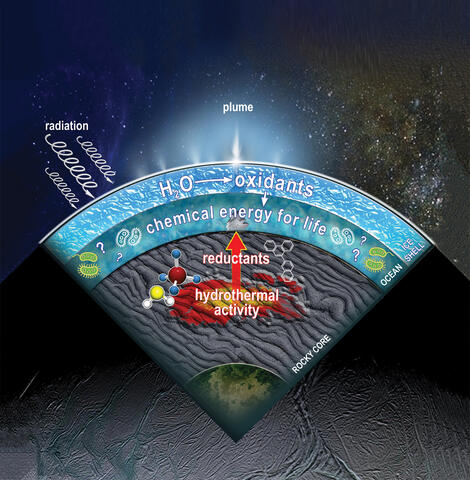
“The detection of molecular hydrogen in the plume indicated that there is free energy available in the ocean of Enceladus,” said lead author Christine Ray, who works part time at SwRI as she pursues a doctorate in physics from the University of Texas at San Antonio. “On Earth, aerobic, or oxygen-breathing, creatures consume energy in organic matter such as glucose and oxygen to create carbon dioxide and water. Anaerobic microbes can metabolize hydrogen to create methane. All life can be distilled to similar chemical reactions associated with a disequilibrium between oxidant and reductant compounds.”
These processes are vital to many basic functions of life, including photosynthesis and respiration. For example, hydrogen is a source of chemical energy supporting anaerobic microbes that live in the Earth’s oceans near hydrothermal vents. Perhaps other metabolic pathways could also provide sources of energy in Enceladus’ ocean.
“We compared our free energy estimates to ecosystems on Earth and determined that, overall, our values for both aerobic and anaerobic metabolisms meet or exceed minimum requirements,” Ray said. “These results indicate that oxidant production and oxidation chemistry could contribute to supporting possible life and a metabolically diverse microbial community on Enceladus.”
Evidence for a Previously Unknown Asteroid
Most meteorites, rocks that fall to Earth from space, are pieces of asteroids. An SwRI-led team of scientists has identified a potentially new meteorite “parent” asteroid, roughly the size of Ceres, the largest object in the main asteroid belt. Studying a small shard of the meteorite Almahata Sitta (AhS), scientists found minerals formed in the presence of water under intermediate temperatures and pressures, providing evidence for a previously unknown parent body.
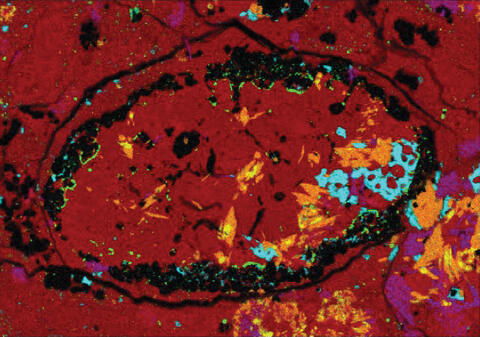
This false-color micrograph of the meteorite sample shows the unexpected amphibole crystals (identified in orange) and points to a large, previously unknown asteroid parent body.
“Carbonaceous chondrite (CC) meteorites record the geological activity during the earliest stages of the solar system and provide insight into their parent bodies’ histories,” said Institute Scientist Dr. Vicky Hamilton, first author of a paper published in Nature Astronomy outlining this research. “Some of these meteorites are dominated by minerals providing evidence for exposure to water at low temperatures and pressures. The composition of other meteorites points to heating in the absence of water. Evidence for metamorphism in the presence of water at intermediate conditions has been virtually absent, until now.”
Asteroids — and the meteors and meteorites that sometimes come from them — are leftovers from the formation of our solar system 4.6 billion years ago. In 2008, scientists spectrally characterized a 9-ton, 13-foot diameter asteroid prior to its entry into Earth’s atmosphere. They tracked the asteroid trajectory as it exploded into some 600 meteorites over Sudan, allowing the recovery of 23 pounds of samples.
“We were allocated a 50-milligram sample of AhS to study,” Hamilton said. “Spectral analysis identified a range of hydrated minerals, in particular amphibole, which points to intermediate temperatures and pressures and a prolonged period of aqueous alteration on a parent asteroid at least 400, and up to 1,100, miles in diameter.”
Support for military mobility
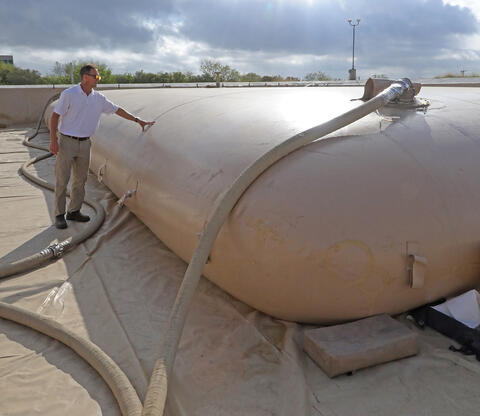
The U.S. Army government-owned, contractor-operated facility SwRI has hosted for more than 63 years was recently renamed the U.S. Army Ground Vehicle Systems Center Fuels and Lubricants Research Facility. The lab provides advanced vehicle fluids research, development and engineering for the U.S. Army and other government agencies.
SwRI recently enhanced facility capabilities with a new enclosure for testing military battlefield fuel bladders, large collapsible containers that can be airlifted to a forward site, filled from large fuel trucks and then used to supply fuel for tactical vehicles. The fuel bladder test facility is equipped with a concrete floor and a surrounding containment structure. SwRI microbiologists are collaborating with fuels and lubricants specialists, evaluating the effectiveness of biocides in enhancing the stability of stored military fuels.

